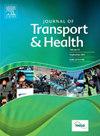Neighborhood facilities and physical self-efficacy of older adults: The mediating role of daily activity opportunities
IF 3.2
3区 工程技术
Q2 PUBLIC, ENVIRONMENTAL & OCCUPATIONAL HEALTH
引用次数: 0
Abstract
Introduction
The social and health benefits of physical self-efficacy have led to a strong interest in identifying neighborhood environment factors related to self-efficacy of older adults. However, little is known about the relationship between neighborhood facilities and physical self-efficacy. This study aims to investigate the structural relationships among neighborhood facilities, activity opportunities, and physical self-efficacy.
Methods
Data were collected through a survey of 788 older adults aged 60 and over living in Dalian, China; commercial, medical and recreational facilities were selected; the built environment characteristics were quantified in terms of location advantages, path patency, environmental comfort, suitability of design, travel convenience and environmental safety; and the relationships were assessed using path analyses.
Results
Daily activity perception was positively related to physical self-efficacy through daily activity participation. A greater presence of sidewalks around food markets and a larger residential area around clinics were associated with higher physical self-efficacy through increased the number of daily activity participation. More streetlights around drugstores and a higher density of main-road networks around gymnasiums were associated with more perceived opportunities for outdoor activities among older adults. The distance between an individual's house and the shopping mall was negatively related to daily activity opportunities and physical self-efficacy.
Conclusions
The findings demonstrated the mediating role of daily activity opportunities in the relationships between neighborhood facilities and physical self-efficacy. These findings have implications for the development of environmental optimization strategies of public service facilities to promote physical self-efficacy among older adults.
邻里设施与老年人的身体自我效能感:日常活动机会的中介作用
导言:身体自我效能感对社会和健康的益处使人们对确定与老年人自我效能感相关的邻里环境因素产生了浓厚的兴趣。然而,人们对邻里设施与身体自我效能感之间的关系知之甚少。本研究旨在探讨邻里设施、活动机会和身体自我效能感之间的结构关系。方法通过对居住在中国大连的 788 名 60 岁及以上老年人的调查收集数据,选取商业、医疗和娱乐设施,从区位优势、路径通畅性、环境舒适性、设计适宜性、出行便利性和环境安全性等方面量化建筑环境特征,并使用路径分析评估三者之间的关系。食品市场周围的人行道越多,诊所周围的住宅区越大,参与日常活动的次数越多,身体自我效能感就越高。药店周围的路灯越多,体育馆周围的主干道网络密度越高,则老年人认为户外活动的机会越多。结论研究结果表明,日常活动机会在邻里设施和身体自我效能感之间起着中介作用。这些发现对制定公共服务设施的环境优化策略以提高老年人的身体自我效能感具有一定的启示意义。
本文章由计算机程序翻译,如有差异,请以英文原文为准。
求助全文
约1分钟内获得全文
求助全文

 求助内容:
求助内容: 应助结果提醒方式:
应助结果提醒方式:


